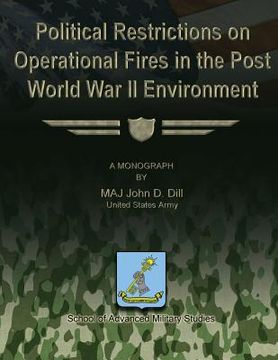Share
Political Restrictions on Operational Fires in the Post World War II Environment (in English)
Us Army John D. Dill
(Author)
·
School Of Advanced Military Studies
(Contributions by)
·
Createspace Independent Publishing Platform
· Paperback
Political Restrictions on Operational Fires in the Post World War II Environment (in English) - Studies, School Of Advanced Military ; Dill, Us Army John D.
$ 14.39
$ 17.99
You save: $ 3.60
Choose the list to add your product or create one New List
✓ Product added successfully to the Wishlist.
Go to My WishlistsIt will be shipped from our warehouse between
Monday, July 08 and
Tuesday, July 09.
You will receive it anywhere in United States between 1 and 3 business days after shipment.
Synopsis "Political Restrictions on Operational Fires in the Post World War II Environment (in English)"
This monograph asserts that the United States military conducted World War II with few restrictions on its firepower beyond those imposed by the International Rules of War. An unlimited war justified unlimited fires, including the strategic use of atomic bombs in August of 1945 to end the conflict. However, World War II proved an anomaly in the twentieth century as America reverted in the post war period to conducting limited wars. Absent a threat to national survival, policy makers ruled out the use of nuclear weapons as a serious option at the strategic level. At the tactical level, commanders had a full array of mortars, tube artillery, and air support. This closely replicated both the concept and effects of what was available to their World War II predecessors. Yet, in limited conflicts, the use of these weapons developed implications beyond their tactical battlefield effects. The monograph examines how strategic policy makers shaped the battlefield for operational fires. At one extreme, the fear of escalation provided an upper limit for field commanders in Korea and Vietnam. At the lower end of the scale, fires previously considered solely tactical in nature had operational and strategic consequences. Stability and support operations (SASO) like the United States Marine Corps intervention in Beirut in the early 1980s came with limitations on commander's ability to employ operational fires. Commanders involved in SASO faced the difficulty of using their weapons without provoking charges of disproportionate response. The monograph also discusses the effect of increased connectivity of the global information environment. For commanders after the Korean War, the results of choices they made were instantly communicated to a worldwide audience. Thus, weapons previously thought to reside solely in the tactical arena now carried an operational, if not strategic, impact. The monograph concludes by arguing that operational artists must be trained to be able to deliver operational fires despite strategic constraints. Operational fires are a critical asset to commanders. Eliminating their effect will significantly reduce the chance of obtaining the desired American end state.
- 0% (0)
- 0% (0)
- 0% (0)
- 0% (0)
- 0% (0)
All books in our catalog are Original.
The book is written in English.
The binding of this edition is Paperback.
✓ Producto agregado correctamente al carro, Ir a Pagar.

